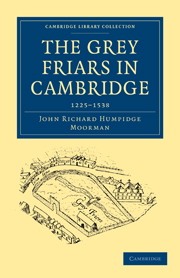Book contents
- Frontmatter
- Contents
- PLATES
- MAPS AND PLANS
- Preface
- Chapter I The House of Benjamin the Jew: 1225–1267
- Chapter II The Friars and the University: 1225–1306
- Chapter III The New House
- Chapter IV Domestic Affairs
- Chapter V Some Activities of the Friars
- Chapter VI The Franciscan School at Cambridge in the Fourteenth Century
- Chapter VII The Latter Years
- Chapter VIII The Dissolution and After
- Appendix A Custodes, Wardens, Vice-wardens and Lectors
- Appendix B Biographical Notes on Cambridge Franciscans
- Appendix C The Dispute between the Friars and the University of Cambridge, 1303–6
- Appendix D James Essex's Observations on the Old Chapel of Sidney College in Cambridge
- Appendix E Fragment of an Account-book belonging to the Cambridge Franciscans
- Appendix F Legacies
- Appendix G Documents connected with the Dissolution
- Appendix H Seals of the Cambridge Franciscans
- Index
- Plate section
Chapter VIII - The Dissolution and After
Published online by Cambridge University Press: 07 September 2010
- Frontmatter
- Contents
- PLATES
- MAPS AND PLANS
- Preface
- Chapter I The House of Benjamin the Jew: 1225–1267
- Chapter II The Friars and the University: 1225–1306
- Chapter III The New House
- Chapter IV Domestic Affairs
- Chapter V Some Activities of the Friars
- Chapter VI The Franciscan School at Cambridge in the Fourteenth Century
- Chapter VII The Latter Years
- Chapter VIII The Dissolution and After
- Appendix A Custodes, Wardens, Vice-wardens and Lectors
- Appendix B Biographical Notes on Cambridge Franciscans
- Appendix C The Dispute between the Friars and the University of Cambridge, 1303–6
- Appendix D James Essex's Observations on the Old Chapel of Sidney College in Cambridge
- Appendix E Fragment of an Account-book belonging to the Cambridge Franciscans
- Appendix F Legacies
- Appendix G Documents connected with the Dissolution
- Appendix H Seals of the Cambridge Franciscans
- Index
- Plate section
Summary
Although few of the Franciscan houses in 1536 could have boasted of an income of more than £200 a year, they were not affected by the first act for the suppression of the monasteries, which was designed to close down all religious houses whose incomes were less than this figure. There are probably two reasons why the friars were excluded in 1536. One is that the first act was not designed to destroy the religious life, but to reduce the number of religious houses. There were at the time several hundred small monastic communities, often comprising only a handful of men or women, and it was thought advisable to close these houses and to give their inmates the choice between ‘taking their capacities’ (which meant seeking secular occupation) or going to swell the depleted numbers in the larger monasteries. As the numbers in the friaries were much more even than in the older monasteries, there was no clear distinction to be drawn between the ‘greater’ and the ‘lesser’ houses, nor was the number of friaries great enough to demand a reduction. Moreover, although the act of 1536 laid stress on the decay of the smaller houses and on their redundancy, there is no doubt that the King had an eye on their estates, which were often out of proportion to the number of men whom they were intended to support.
- Type
- Chapter
- Information
- The Grey Friars in Cambridge1225–1538, pp. 127 - 142Publisher: Cambridge University PressPrint publication year: 2009First published in: 1952

